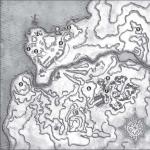Autumn treatment of fruit trees with urea. Processing garden trees in autumn
You need to take care of the condition of the garden and improve fruiting in the fall. For disease and pest control, this is the most best time. Let's talk about protective spraying of fruit trees, how and with what to process.
Autumn processing is considered the most effective, as it stops the active reproduction of bacteria that oppress the tree, destroys the larvae of harmful insects. With the help of spraying, you will get rid of problems with scab, putrefactive infections, spots and other misfortunes. Important conditions for such work are the absence of frost, dry weather.

Preparation and processing method
The process of therapeutic and preventive manipulations is not complicated, but requires compliance with certain rules. AT middle lane takes place in October.1. Trees older than 6 years old, with lichen on the bark, must be skinned with a metal garden brush. The areas affected by neoplasms should be cleaned, as well as removed upper layer old bark. These measures are important to deprive insects of shelter and improve the impact of the applied solution.
2. Spraying is best done immediately after cleansing the bark, in dry weather.
3. The final processing takes place after the complete fall of the foliage or after the first frost. Before that, all branches, debris, leaves are removed under the tree, weeds are mowed. Such actions are important, as the trunk circle will spill.
How to process trees in the garden

Three types of solutions are mainly used: urea, copper and inkstone. These drugs have different effects on specific types threats. Therefore, the processing is done different means. Depending on the condition of the tree, the desired preparation is selected.
inkstone
It is a healing and nourishing remedy recommended for apple, cherry, plum, peach trees. As a result of spraying, the tree is enriched with iron and other important trace elements. As a result, the condition of the plant improves, oxidative processes intensify.

blue vitriol
Ideal against scab, putrefactive diseases on pear, plum, apple, cherry. It contains a fungicide, therefore it is used against all spots and powdery mildew. Curly, coccomycosis, moniliosis, clasterosporosis are treated on plums. Processing protects apple and pear trees from phyllosticosis, scab, monioiosis.
Experts advise applying spring / autumn twice and not only for trees: beds are shed and garden plants. The consumption of copper sulfate per tree older than 6 years should be 2 liters, for an old one with a large crown it can take up to 10, dilute 500 g in 5-10 liters. Mandatory conditions for obtaining the effect: complete wetting of the branches and the table, the air temperature parameters are not lower than +5, the absence of wind.
Urea (urea)
It is used in autumn for primary or final processing (before leaf fall and after). Contains 46% nitrogen and is an effective nitrogen fertilizer. In addition, urea is detrimental to the larvae of numerous pests, so the first treatment is carried out with a 7% solution at the time of shedding half of the foliage, and after the final fall of the leaves, a highly concentrated composition is used - 500 g per 10 liter bucket.
Carbamide is added not only to the stem, branches, but also to the near-trunk land along the projection of the crown. It is impossible to deviate from the percentage when diluting the powder, since premature leaf fall is possible, which will negatively affect the preparation of the tree for winter and reduce frost resistance.
Have you ever paid attention to city plantings? All of them do not look very aesthetically pleasing: all kinds of bugs frolic on the trunks, branches and foliage look unhealthy. It's all about improper care and failure to perform such an important procedure as tree care in autumn. Why is it carried out this event, as well as what means to use we will talk in this article.
If you are looking not for information on this issue, but for professional gardeners who are ready to work for you on the site, you have come to the right place. We offer the following services: processing bushes and trees in autumn, preparing the garden for winter, autumn top dressing. We provide quality care for every plant! Call! :)
Autumn work
Processing trees in the garden in autumn has the following functions:
- Destruction of pests;
- Fight against pathogenic microorganisms;
- Defense against winter pests (hares, mice) and frost protection.
These tasks are solved using several procedures:
- spraying;
- whitewash;
- installation of protective equipment.
Processing trees and shrubs in autumn for disease prevention is the spraying of plants with fungicides. If this event is not carried out, microorganisms (causative agents of diseases) can spread to all plantations. Warm, humid weather favors the rapid growth of bacteria. If the garden is not sprayed in time, in the spring it will suffer from various diseases and fungi.
A mandatory procedure in the care of the garden is treatment of trees in the fall from pests. Just at this time, insects are going to hibernate. They equip themselves with a winter lodging for the night in the bark of plants, on branches, in tree trunks. To destroy most types of insects, it is enough to hold sanitary pruning and digging trunk circles. For the destruction of insects hiding in the pores of the old bark, the boles are whitewashed.
Processing tree trunks in the fall includes the following procedures:
- cleaning boles from old bark with a scraper or a metal brush;
- treatment of injuries (putty garden pitch);
- whitewashing with a special whitening compound.
Such processing will destroy the "nests" and burn the eggs and pupae of insects. For effectiveness, insecticides are added to the composition for whitewashing.
Processing trees in autumn for the winter includes installation of heaters on stems - exactly this weakness in a plant, if a tree gets frostbite on a trunk, the chances of its survival will be close to zero. To protect the plant, the trunk is wrapped with roofing material or roofing felt (height - about 1 m), in especially frosty areas it is recommended to lay a burlap or straw gasket between the roofing material and the bark.
Provide rodent safety very simple:
- lay out poisonous baits in the garden (will save from mice);
- wrap the trunk over the "fur coat" with barbed wire (protection from hares).
Tree processing in autumn video
You can use urea (urea), copper or iron sulfate, 3% Bordeaux mixture for this. But the treatment is carried out not with these four preparations, but preferably with one of them during the period when the foliage completely falls, but before the onset of frost.
Autumn treatment of fruit diseases with urea
This is a highly effective granulating fertilizer containing nitrogen, which is necessary for the growth and development of plants, in an assimilable form. Its mass fraction in fertilizer is 46%. Urea is the most popular spray. It can be used both in autumn and spring. AT autumn period the concentration is taken at the rate of 500-700 grams per 10 liters of water. At the same time, it burns out many fungal diseases, even some of the pests that are trying to winter on fruit trees.
Treating the garden with urea in the fall is a chemical treatment, not a fertilizer for trees. It is carried out over the entire crown of a tree or berry bush, and the surrounding land around the tree is necessarily sprayed nearby. Almost all pome and stone fruits, as well as berry bushes, are sprayed with urea.
Autumn processing of the orchard with copper sulphate
The drug is considered a fungicide to combat diseases of berry, fruit (pome and stone fruits), ornamental crops. It is a good prophylactic various kinds fungal diseases on plants. The concentration of copper sulfate is chosen depending on the type of plant. So, for spraying apple and pear trees, as well as quince, it is necessary to make a concentration at the rate of 100 g of the drug per 10 liters of water. And for stone fruit crops, like plums, cherries, cherries, as well as peaches and apricots, use a different concentration - 50-75 g per 10 liters of water. The same concentration is used for spraying berry bushes.
Processing of trees is done after the leaves have completely fallen off, carefully processing the branches and trunk of the tree.
Our advice
Due to the poor solubility of iron sulphate in cold water, it is desirable to warm it up. First, it is desirable to dilute the vitriol in a small amount warm water, and then mix with the main volume.
Autumn processing of trees in the garden with iron sulphate
This is a means to combat various garden pests, fungal spores, mosses and lichens. This tool is not only used to control diseases and pests, but it can also fill the need fruit trees in iron. Especially this element is necessary for apple, pear and plum.
On average, the concentration of the solution is used at the rate of 300 g of vitriol per 10 liters of water. But there are some nuances. For example, for spraying gooseberries, currants, raspberries, use 250 g of vitriol per 10 liters of water, for stone fruits - 300 g of the drug and pome fruits (apple and pear) - 500 g per 10 liters of water. Spraying is carried out on a bare tree, near-trunk circle and the ground around the tree.
Bordeaux mixture for processing the orchard in autumn
An effective remedy autumn struggle with pests and diseases, the treatment of fruit trees, shrubs and berries with a 3% Bordeaux mixture is considered. The solution can be prepared independently: dissolve 300 g of copper sulfate in 5 liters of warm water. In the next 5 liters, dilute 400 g of lime and, stirring constantly, pour the vitriol solution into the lime solution in a thin stream.
You can buy a package of ready-made Bordeaux mixture, only then dilute it in the recommended volume of water.
Bordeaux mixture well destroys all types of spotting, scab and many more fungal diseases (curly, moniliasis, coccomycosis, clasterosporiasis, etc.). Process all shoots and trunk.
It must be remembered that the processing is carried out in dry calm weather. It is important to take measures for personal protection.
Miron DATSKO, Ph.D.
Institute of Water Problems and Land Reclamation NAAS
photo depositphotos
When preparing the garden for winter, it is important to make sure that uninvited guests do not stay on the trees and shrubs for the winter. From diseases and pests, horticultural crops must be sprayed with preparations that serve as fertilizers and help to cope with infections, bacteria and larvae. Compliance with the terms, rules and stages of spraying is the key to successful processing of the garden in the fall.
Terms of processing the garden in the fall from diseases and pests
Autumn processing of horticultural crops from pests and diseases should be carried out in calm, preferably sunny weather.
- You need to be sure that there will be no rain in the next few days, otherwise all treatments will have to be repeated, the rain will simply wash everything away.
- Processing must be carried out before frost, that is, when the temperature outside the window is above zero.
- In frost, it simply makes no sense to carry out treatments in the garden against pests and diseases.
Usually, plants can be sprayed with preparations at the end of October.

Preparing trees for processing in the fall from diseases and pests
Before proceeding directly to the use of drugs and processing plants, you need to prepare the plants for processing.
- Tree crops that are more than 7 years old necessarily have lichens and old bark on their surface. All this, even before processing, using special brushes and scrapers, must be carefully removed, and the places should be treated with a weak solution of potassium permanganate and covered with garden pitch, and even better, painted over with oil paint.
- Mandatory removal of all plant residues in the near-stem strip and on the plant itself - leaf blades, mummified or dried fruits.
- The affected branches need to be cut out and cover the saw cuts with garden pitch or garden paint.
__________________________________________________________________

Preparations for treating the garden in the fall from diseases and pests
Most often for spraying trees and shrubs use:
Urea is usually used for the treatment of fruit trees, and such treatments can be performed several times during the autumn period.
- The first treatment can be carried out with a 3% solution of urea, when there are still leaf blades on the trees.
- By the beginning of November, when usually the trees are completely bare, you can repeat the treatment by increasing the concentration to 6%.

Rules for processing the garden in autumn
- Everything needs to be processed - the bite zone, each branch, shoot, stem. Thus, you protect the plant and, in fact, make foliar top dressing.
- Never increase the dosage of the fertilizer, otherwise you may burn the bark of the trees.
- Be sure to get a knapsack sprayer, where pressure is applied using a lever, the sprayer itself is hung on the back and thus a full-scale treatment of the entire plant is performed.
Watering after processing
About a week after treatment, it is recommended to water the trees, pouring out 15-30 buckets of water per week.
____________________________________________________________________
Whitewash after treatment
- After another week, when it definitely won’t rain, whitewash the trees to the first skeletal branches.
- By the way, the layer of whitewash must be at least 3 cm, otherwise it will not be of any use.
____________________________________________________________________
____________________________________________________________________
The pre-winter preparation of the garden should be treated with special attention, because it depends on how the plants will be ready for spring. Autumn processing of the garden from pests is aimed at combating the following factors:
frost action.
insect pests;
microorganisms - causative agents of diseases;
Artificially bred plant cultures are more in need of care than wild ones. Garden processing in the fall from pests includes the following activities:
Plant pruning
When summer is already over, it is necessary to do preventive pruning. Diseased shoots, branches located at an acute angle and growing deep into the crown are removed. Autumn can drag on and cause plant growth due to warm weather. There are many tops that must be removed.
For the southern regions, autumn and winter full pruning is suitable, but in the northern regions it is undesirable to do it. The cut may begin to dry out, or the bark freezes around it. This is especially true for young trees. Seedlings are cut only if the branch interferes with others.
It is important to form trees in tiers and leave the lower branches thicker than the upper ones. If one of the shoots begins to stand out among the others, it is shortened by a third more.
Tree whitewashing. Training
Processing the garden for the winter by whitewashing tree trunks is a necessary step in preparing for the cold.

They are cleaned of old bark and moss with a scraper and an iron brush. To prevent pests from falling to the ground, a cloth or film should be laid under the tree. Cracks in the bark must be repaired with garden pitch. Whitewash mixes are sold ready-made. You can use homemade ingredients.
Ingredients for whitewashing
The ratio of the components of the mixture for whitewashing:
slaked lime - 3 kg;
copper sulfate - 450 g;
casein glue - 80 g;
water - until the consistency of sour cream is reached.
Another old and reliable recipe:
slaked lime - 2 kg;
copper sulfate - 250 g;
clay - 1 kg;
cow dung - 1 kg.
The presence of lime and clay in the suspension makes the coating gas-permeable. You can also use acrylic and water-based paints.
positive action
When cleaning the bark and applying a protective layer, it will be reliably cleaned of harmful insects and microorganisms. Autumn processing of the garden from pests allows you to burn insect eggs on the trunks. Efficiency is increased by the addition of copper or iron sulphate and insecticides, such as karbofos. Glue or clay can be used as a binder. By adding a tablespoon of carbolic acid to the suspension, you can be sure that mice and hares will not approach the trees.
Whitewashing in the fall protects the trunks from frost, preventing pests and fungi from penetrating into them. All resulting waste must be incinerated. Vegetation remains should not be left on the ground. This helps to destroy insect pests and disease-causing organisms.
Gardening in September includes digging up the soil.

In this case, the weed should be removed and buried in. Then the spores of clusterosporiosis and coccomycosis will be destroyed.
Spraying plants from diseases and pests
Most of the pests and disease sources in the garden are picked up at the time of maturation and harvest. Chemicals during this period is prohibited.
Urea
After harvesting, trees and shrubs are sprayed with a solution of urea (5%), which protects them from scab. They process the trunks and branches of plants, as well as the soil under them. The area under the tree must be sprayed. Carbamide activates vegetative processes in plants, saturating them with nitrogen. This can adversely affect plants that do not have time to adapt to the cold. Autumn processing of the garden from pests by spraying should be carried out no later than a month before the onset of frost. The garden must be fully prepared for winter.
Before you start spraying plants, you need to provide yourself with a respirator, gloves, goggles and tight clothing. Dry and calm weather is chosen for work.
blue vitriol
From scab, powdery mildew, coccomycosis and other diseases, the processing of the garden, in particular stone fruit and pome crops, as well as currants, grapes, gooseberries, helps.

To increase efficiency, lime is added to the solution (Bordeaux mixture). In autumn, spraying will be more effective, because the concentration can be increased up to 3%. In the spring, such a solution can destroy or damage the leaves. everywhere is on sale, and you can make it yourself if you dilute 400 g and 300 g of copper sulfate in 20 liters of water. Instead, you can use the Burgundy mixture, replacing the lime with 250 g of soda ash. For better adhesion, a soap solution is added to it. It should not be introduced into the Bordeaux liquid due to folding into insoluble lumps. This spraying is the last of the season. Too early to produce it is not worth it, as the leaves will get burned and fall off the trees. ahead of time. November is the best time.
inkstone
Autumn processing of the garden (5-7%) makes it possible to get rid of moss and lichen. To do this, they spray old trees.

Autumn treatment with iron sulphate allows you to better prepare plants for winter. Unlike Bordeaux liquid, lime cannot be added to it. Spraying them has the same effect as gardening blue vitriol, but at the same time, plants are saturated with iron, which has a positive effect on oxidative processes in stone fruit and pome crops. To completely get rid of certain diseases, it should be used in combination with by special means. Insecticides are added to copper or iron sulfate to increase the effectiveness of the solution in controlling insects.
Tying trees for the winter
For the winter, tree trunks are tied with branches of spruce, juniper, raspberry, roofing material, film, metal mesh. At the same time, earth should be poured on the side so that rodents do not crawl from below.

The binding also protects the bark from sunburn. As snow falls, it is additionally poured to the trunks. Mice like to overwinter in plant debris, which should be removed and not left on the ground. In places where rodents may live, poison baits should be laid out. The snow around the tree trunks is trampled down so that the mice do not get through the dense layer. Fences around the site help to protect against hares.
In April, the strapping is removed. It is advisable to do this on cloudy days so that the plants adapt to the sun's rays.
In this way, autumn processing garden from pests in the form of the above activities allows you to protect trees and increase their productivity.





